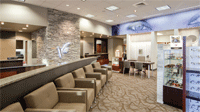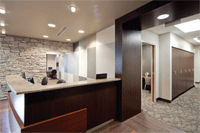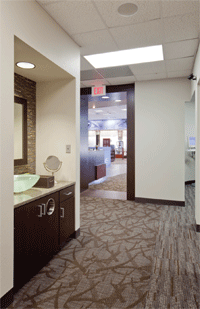From the moment patients enter your door, their experience can be affected by the way in which they move through the office. Your patients’ perception of your practice can be greatly enhanced when the proper layout is in place. Even with the most innovative equipment and treatments, patients can come away feeling less-than-satisfied with their visit due to poor layout design. In this article, we’ll take a closer look at office design and how you can optimize your practice space to ensure efficiency and patient satisfaction.
Ask the Experts

Offering seating in your optical display area encourages patients to peruse your frame selection.
When beginning to design your layout, utilize the services provided by companies that manufacture the furniture and equipment you will need in your new space.
These professionals have years of experience and know what aspects of design are current and work in today’s environment. In many cases, they can get you started and you can then tweak the design to best fit your particular space, infusing it with your own personality. Hiring a professional to help with your design can greatly decrease the stress that can accompany making these decisions. A designer is especially helpful in a multi-doctor practice because, in many cases, all of the owners have difficulty agreeing on the details of the design.
“Design of any eye care practice is a process,” says Andrew Fader of Eye Designs Inc. “Every doctor and every practice has their own ideas and philosophy, but every office needs a design that is efficient.” Combining your own ideas and those of a professional designer will ensure those factors are in place when the project is completed.
In many cases, these services are free and provided by these designers in hopes you will purchase the materials for your office from them. In other cases, there may be minimal charges to design your space and that amount may be credited against future purchases.
As a doctor, you may not be up-to-date on the current colors, carpets and other treatments, so this is another area where an interior designer can be of great benefit.
These services can be costly, however, and discussions with the designer concerning fees should occur early on. When an agreement on treatment consultation is made, be certain to have a contract in place to clearly define what you will receive for those fees.

Check-in and check-out areas should be separate to avoid unnecessary traffic and patients overhearing conversations about other patients’ billing/insurance specifics.
In addition to interior designers, you will likely require the services of architects and engineers. Hiring an architect can have a tremendous impact on the efficiency of your practice because these professionals advise on how to best utilize the space you have. For instance, in the event of a remodel, an architect will help you reconfigure the electrical and HVAC systems to accommodate new space and equipment. Or, if walls are being eliminated or doors moved, architects and engineers can determine the proper way to accomplish this while conserving the structural integrity of your space. Forgoing these items may create a great deal of hassle, not to mention cost, in the long run.
Check with other optometrists and medical professionals in your area for architects and designers that have experience with your type of practice and needs. Don’t hesitate to interview them to determine if they have similar ideas.
First Impression
The entrance to your office should initiate the “wow” factor you want to convey to your patients. You want your patient to think, “I can’t get this anywhere else.”
Consider what the patient will see when they enter. What will they feel? What will they smell? Just inside the front door is a decompression zone where the patient looks and determines where to go next for the service they require. Be certain that it is clearly defined. Someone should greet them immediately and help them begin the process of satisfying their eye care needs.
No office should ever have a “waiting room”—a lobby or reception area must greet your patients and allow them to be comfortable while they wait to see the doctor.
This area should be in the optical display area or directly adjacent to it; this strategic placement encourages patients to browse through your frame selection while they wait.
When considering whether to provide a TV in the reception area, there are many options to consider. You could offer regular programming, such as news, or you could run various videos from commercially available programs that educate and inform your patients about products and services. Audio is another consideration—based on what works best in your setting, you could turn on audio of whatever program you choose or mute it and play background music.
Plan Ahead

When planning your exam room layout, don’t forget to allot space for sinks and computers.
• Ease of movement. As patients move through the clinic of your office, you must be certain they take as few steps as possible. This is why you need to organize your testing to eliminate backtracking.
Pretesting should result in only a few moves for the patient. This can be accomplished by having one pretest table for each doctor. Boomerang-type tables will hold several pieces of equipment so the patient can have several tests done from one chair. On these tables you can have a computer station, lensometer, autorefractor, keratometer, topographer, frequency-doubling technology (FDT) and do acuities by using computerized charts. Next, you can move to another station for retinal photos, Optomap (Optos) and/or specular photography.
After the pretest, patients can be escorted to the exam room for their visit with the doctor. If further testing is required once the doctor visit is complete, another room for special testing will be necessary to do optical coherence tomography (OCT) or a visual field test, for example. Because the test is subjective, the visual field instrument requires a room with less interruption and the ability to control the lighting.
Hallways should be wide enough to allow multiple patients to pass through at one time. Wheelchairs and other motorized carts must be able to move through and pass patients and staff comfortably, so keep this in mind when planning the width of your hallways. If your space allows for a circular or square layout—where patients don’t have to exit the same way they entered—your hallway can be a bit narrower.
• Front desk. Your front desk area is one of the most important sectors in the office; it’s where nearly all financial transactions occur. When planning this area, try to split the check-in and check-out areas. This allows patients to check in and start their experience away from the area where they may hear a discussion regarding insurance and balances due. One of the most common bottlenecks can occur at check out. On average, offices need more staff and equipment available for check-out than check-in. The check-out process generally takes a little longer than check-in, and there are more steps in this area to complete the visit.
• Exam rooms. Exam rooms are the lifeblood of the practice. You should have at least two exam rooms for each doctor, but having three exam rooms for each doctor is ideal. This setup allows patients to remain in the room while the practitioner dilates them and fits them with contact lenses. This way, the doctor can go on to the next patient much more efficiently and patients are not shuttled in and out of exam rooms and waiting areas. Considering that the chart distance should be 20 feet, your exam room should be about 11 feet by nine feet. It’s a good idea to include sinks and computer storage when designing your desks. But, don’t overlook aesthetics when thinking practically—messy cables and CPUs should be well hidden from patient view.
• Staff. Be certain to allocate space for staff-only areas. Your staff needs an area they can use for lunches, breaks and other free time. If you have space, give your staff their own restroom, shelving, lockers or drawers for their personal items and a small kitchenette. Remember, a content staff will increase the productivity significantly.
• Doctors’ offices. Offices for the doctors do not need to be significant in size. Practitioners spend more of the day in the exam room, so the office only requires an area for a desk, phone and computer. A private restroom for the doctors is always a plus and should be considered when space is available.
• Restrooms. Patient restrooms should be out of sight of the main optical and exam areas but at the same time, easily accessible. Some city codes require restrooms and restroom entrances to be of certain sizes, allowing for accessibility for disabled patients. Make sure to research this thoroughly in the planning stage to avoid having to redo this part of the office later. Don’t skimp on the design of the patient restrooms. These rooms need to be warm and comfortable, leaving the same impression as the rest of your office.
• EHR and diagnostic tools. Almost all parts of a modern optometric exam and optical sale are computerized. Electronic health records (EHR) are very common and will be a part of all offices very soon.
Most instruments can now be networked, and many integrate with the optometric office software. When designing pretest, special testing or diagnostic rooms, consider running computer ports and electric to all sides of the rooms; this way, equipment can be moved when necessary. Most doctors have seen a significant change in the number of diagnostic instruments that are used now, and it is impossible to predict what may be available in the future. For this reason, some rooms may need multiple connections for multiple pieces of diagnostic equipment and computers.

Wide hallways ensure that both patients and staff feel comfortable as they move through your office.
• Optical. No matter how hardworking and efficient the doctor is, much of the revenue in most practices is generated by the optical area. Of course, what the doctor does in the exam room drives most of the activity in the optical, but the layout and design of the optical can make a tremendous difference in total sales of any practice. Ideally, the patient should enter and exit through the optical area. Exposing patients to your high-quality space at the beginning and the end of the visit will increase sales.
A well designed optical has separate areas for sales and adjustment. It is not suggested to have adjustments and pickup areas in the same area as sales of new materials. Occasionally, all opticals have disgruntled patients that require additional care. You do not want patients who are considering their new purchase to hear another patient complaining about their situation. Also, computer workstations have to be included in the optical design so sales can be made from each sales desk.
Frames need to be displayed in a variety of ways. Frame boards are still the most common and will allow the most frames to be seen in given space. But, simply hanging frames on frame boards and rounders is not enough. Some frames need to be displayed on glass and stainless shelves. Another way to go is displaying frames in built-in cubbies. Allow space in the optical for accent pieces of art, pottery or flower arrangements to dress up and make the area more inviting. Remember, this is a retail area, and it needs to be treated as such.
Make sure to only use those displays that fit well with the type of design you have used throughout your office. Optical areas must be evaluated and updated on a regular basis. “The perception that your practice is up-to-date is not going to be there if the frame boards and displays are not up-to-date,” says Lori Estrada of Fashion Optical. “Patients want to know that you have your finger on the pulse of what is modern and fashionable and the way you display your frames can do just that.”
Proper planning is the most essential factor in designing a new office or remodeling a current office. It serves as the foundation of the entire project, without which the process can be extremely frustrating and stressful. With the help of professionals, the end result can be a location that is a pleasure for both you and your patients—in turn, making it beneficial for the growth of your practice.
Dr. Herndon is in private practice in Springfield, Mo. He is a member of the American Optometric Association, the Missouri Optometric Association, the Greater Ozarks Optometric Society and the Heart of America Contact Lens Society.

